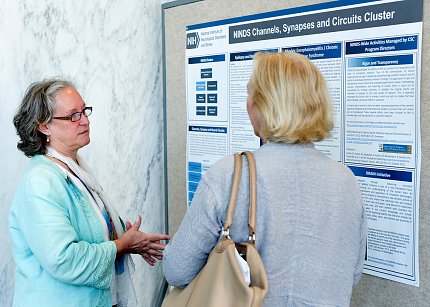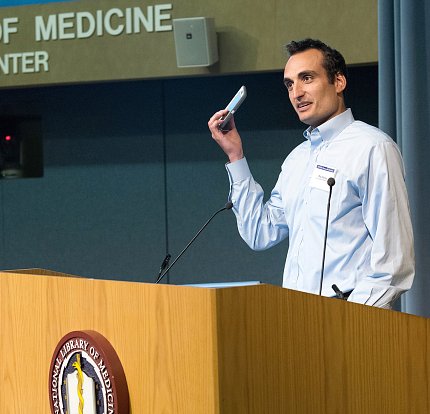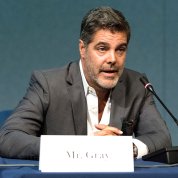SO PATIENTS ‘FEEL, FUNCTION & SURVIVE BETTER’
NINDS, Nonprofits Work Toward Shared Goal at Forum

Photo: Andrew Propp
Representatives from more than 75 nonprofit organizations across the country recently attended NINDS’s 10th nonprofit forum, “Progress through Partnership.” The 2-day meeting, which focused on data and clinical trial readiness, gave patient advocacy groups an opportunity to learn more about NIH and NINDS and network with each other and staff.
“Everybody here is traveling the same path—to try and get better therapies for patients with neurological disorders,” said NINDS director Dr. Walter Koroshetz. “The idea, from all points of view, is that working together is what is going to get us there…The name of the game is high-quality data. The goal…is to discuss how best to acquire the data needed to empower therapeutic trials. We want to empower the organizations to move therapy development forward to therapeutic trials, but also to power the trials so you get the answers you are looking for.”
The meeting began with experts sharing lessons in developing natural history databases, challenges and opportunities for data integration and management, and strategies for biomarker identification.

Photo: Andrew Propp
“The thing that is important is that partnerships can be developed with the NIH programs,” said Steven Kaminsky of the International Rett Syndrome Foundation, addressing nonprofit colleagues. “Don’t try to build something yourself that costs a lot of money for your foundation and is going to break your bank account…Your future is through your past and your past is a really good natural history study. NIH, through the National Center for Advancing Translational Science’s Office of Rare Diseases Research and the Rare Disease Clinical Research Network, has essentially built a foundation for all of us to use. You just have to figure out how to use it.”
Acting NINDS deputy director Dr. Alan Willard presented a primer on NIH and NINDS funding, priority-setting and decision-making.
“I’m going to take you through the life cycle of an idea,” he said as he described how a new grant award is made—from the initial plan of the investigator/organization, through various scientific review processes and finally to the funding itself. Willard concluded with ways organizations can affect the process such as helping principal investigators recruit for clinical studies or recruiting young investigators to the field.

Photo: Andrew Propp
Ron Bartek of the Freidreich’s Ataxia Research Alliance and NORD led a panel on developing better clinical outcome measures. The session’s speakers talked about classic measures as well as innovative technologies and approaches for collecting and tracking data including telemetry using wearables and smartphone apps.
“If you understand your patient and your patient’s natural history, you are far better able to select the clinical outcome measures and biomarkers that measure what’s most important to that patient,” he said. “The trilogy, the gospel, is what makes the patient feel, function and survive better.”
At a breakout session on Ultra Rare Diseases, Dr. Petra Kaufmann of NCATS spoke about GARD (Genetic and Rare Diseases Information Center)—a service designed to provide comprehensive information about rare and genetic diseases to patients, families, health care providers, researchers and the public. GARD was developed in collaboration with NCATS and NHGRI. According to Megan O’Boyle of the Phelan-McDermid Syndrome Data Network, “[GARD] is not reinventing the wheel. It’s putting all the spokes in one place.”
A new forum highlight featured posters representing nonprofit organizations and NINDS programs. Attendees were able to explore the various programs in an easy-to-understand way. Also new this year was the inclusion of the industry perspective on therapy development represented by Dr. Sean Ekins of Phoenix Nest and Dr. Ronald Marcus of Cerecor.
Dr. Cynthia Rothblum-Oviatt of the A-T Children’s Project moderated “Cultivating Collaboration on a Shoestring and Investing in the Intellectual Pipeline,” which focused on building a multi-stakeholder network and best practices for finding, funding and retaining researchers.
Panelist Dr. Carsten Bönnemann of the NINDS Neurogenetics Branch presented models of two clinical trials of rare pediatric disorders that involved multiple stakeholders including government, academia, industry and advocacy groups. Another panelist, Tish Hevel of the Brain Donor Project described her work on raising awareness of and simplifying post-mortem brain donation.
The meeting ended with success stories from the Charlotte and Gwenyth Gray Foundation, CurePSP and the Alzheimer’s Association. Their topics ranged from leveraging resources, to network building, to strategic planning.



